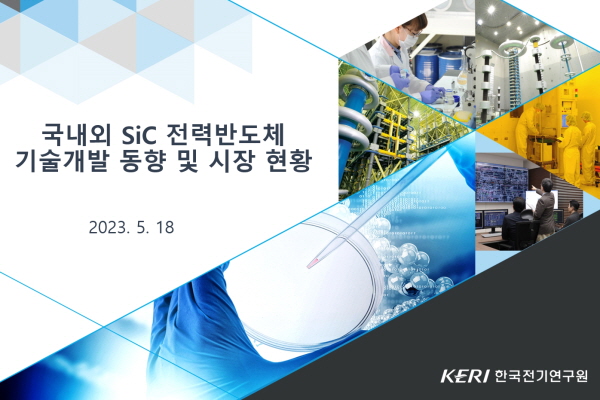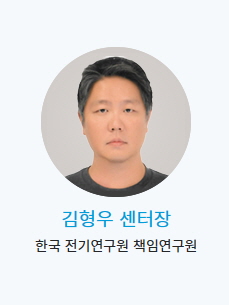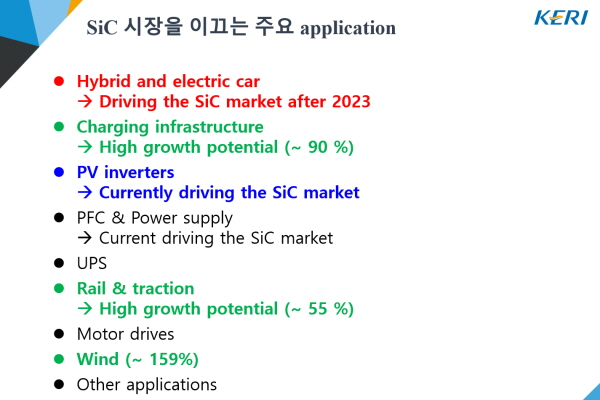SiC 전력반도체 기술이 전기자동차, 충전기, 태양광 등과 같은 애플리케이션에 적용이 가능한 1200V ~ 1700V급 수준 소자를 넘어 앞으로는 특성을 더 개선하는 형태로 기술 개발이 이루어질 것이라는 전문가의 분석이 제기됐다.
 우주항공 등 극한 환경 적용 위한 고온 SiC 전력반도체 기술 주목
우주항공 등 극한 환경 적용 위한 고온 SiC 전력반도체 기술 주목
E-모빌리티 위한 SiC 전력모듈 기술 중점…충전시간 단축·신뢰성 必

SiC 전력반도체 기술이 전기자동차, 충전기, 태양광 등과 같은 애플리케이션에 적용이 가능한 1200V ~ 1700V급 수준 소자를 넘어 앞으로는 특성을 더 개선하는 형태로 기술 개발이 이루어질 것이라는 전문가의 분석이 제기됐다.
김형우 한국전기연구원 센터장은 지난 5월18일 마우저 파워세미나 ‘국내외 SiC 전력반도체 기술개발 동향 및 시장 현황’ 세션에서 시간 관계상 답하지 못했던 질문에 대한 답변을 남겼다.

▲김형우 한국전기연구원 센터장 마우저 파워세미나 2023 발표 자료 캡쳐
■ 2023년에 많이 성장하고 발전할 것으로 예상되는 SiC 전력반도체 기술은 무엇인가
SiC 전력반도체 기술의 경우 지금까지는 MOSFET, SBD와 같은 개별 소자 중심으로 기술 개발이 이루어져 왔으며, 개발된 소자들의 정격도 전기자동차, 충전기, 태양광 등과 같은 애플리케이션에 적용이 가능한 1200V ~ 1700V급 수준의 소자들을 중심으로 개발됐다.
위와 같은 소자들은 현재 국내외적으로 기술 개발 및 사업화가 완료된 상태로 앞으로는 특성을 좀 더 개선하는 형태로 기술 개발이 이루어질 것으로 보여진다.
2023년 이후에는 △대전력 응용분야에 적합한 3300V – 6500V급 SiC 개별 전력반도체 소자 △우주항공, 지열발전 등 극한 환경 적용을 위한 고온 SiC 전력반도체 기술 △전기차 고속 충전을 위한 SiC 전력반도체 소자 대전류화 기술 △All-SiC module 기술 개발을 위한 SiC 소재 기반 집적회로 기술 △차세대 E-mobility (전기차, 유인 드론 등)를 위한 SiC 전력모듈 기술에 중점을 두고 연구개발이 진행될 것으로 판단된다.
이외에도 더 많은 기술들이 있겠지만 우선은 위의 기술들을 중심으로 연구개발이 진행될 것으로 예상된다.
■ EV와 충전 인프라에 SiC 전력반도체를 최적으로 적용하고 활용하려는 경우 중요하게 고려하고 테스트해야 할 요소는 무엇인가
가장 중요하게 고려할 부분은 △충전 시간 단축을 위한 power level 향상 기술 △이동가능한 거리 증가를 위한 효율 향상 기술 △ 안정성 확보를 위한 신뢰성 향상 기술 △V2G 애플리케이션을 위한 flexibility 기술과 같은 것들이 있다.
상기 요소들 가운데 시장에서 가장 우선적으로 요구되고 있는 기술은 충전 시간을 단축할 수 있는 고속 충전 기술과 탑승자의 안전을 위한 신뢰성 향상 기술이다.
구체적으로는 △고속 충전을 위한 DC 충전 인프라 △고속 충전기에 필요한 400 – 800V급 배터리△충전기의 교환 주기 향상을 위한 소자 신뢰성 향상 등이 있다.
■ CMOS와 바이폴라의 차이점은 무엇인가
CMOS Transistor는 △Low-power △High-noise immunity △High-integration density를 필요로 하는 애플리케이션에 적합한 소자인 반면 바이폴라 Transistor는 △High-power △High-gain △High-Linearity를 필요로 하는 애플리케이션에 적합한 소자다.
다만 SiC의 경우 SiC 소재 기반의 집적회로 기술 개발이 이제 시작하는 단계이고, SiC를 이용한 소자 공정이 어렵기 때문에 CMOS를 이용한 집적회로 구현에 많은 어려움을 겪고 있다.
국외의 일부 대학 및 연구기관 등에서 SiC CMOS를 이용한 Digital Logic 회로나 SiC MOSFET용 Driver를 연구하고 있으나 여전히 해결해야 할 문제들이 많이 남아 있다.
■ Full SiC Module의 Short circuit 내량은 Si 기반 Power Device와 어떤 차이가 있나
SiC 소재 기반 전력반도체 소자의 경우 Si 기반 전력반도체 소자에 비해 전도성이 높은 것이 장점이다.
반면 뛰어난 전도성 때문에 SiC 소재 기반 전력반도체 소자의 Short-Circuit Withstand Time은 Si 기반 전력반도체 소자에 비해 아주 짧은 편이다.
이러한 이유로 SiC MOSFET용 Short-Circuit Detection 회로는 빠른 응답 속도와 높은 Bandwidth를 필요로 한다.
■ SiC MOSFET도 제작 시 트렌치 MOSFET처럼 자동으로 기생 Diode가 생성되나
SiC MOSFET의 경우도 Si MOSFET과 마찬가지로 소자 제작 시 Source-Drain 사이에 Body가 형성된다. 이러한 Body Diode는 Parasitic Diode 또는 Internal Diode라고 불리기도 한다.

 SiC 전력반도체 기술이 전기자동차, 충전기, 태양광 등과 같은 애플리케이션에 적용이 가능한 1200V ~ 1700V급 수준 소자를 넘어 앞으로는 특성을 더 개선하는 형태로 기술 개발이 이루어질 것이라는 전문가의 분석이 제기됐다.
SiC 전력반도체 기술이 전기자동차, 충전기, 태양광 등과 같은 애플리케이션에 적용이 가능한 1200V ~ 1700V급 수준 소자를 넘어 앞으로는 특성을 더 개선하는 형태로 기술 개발이 이루어질 것이라는 전문가의 분석이 제기됐다.